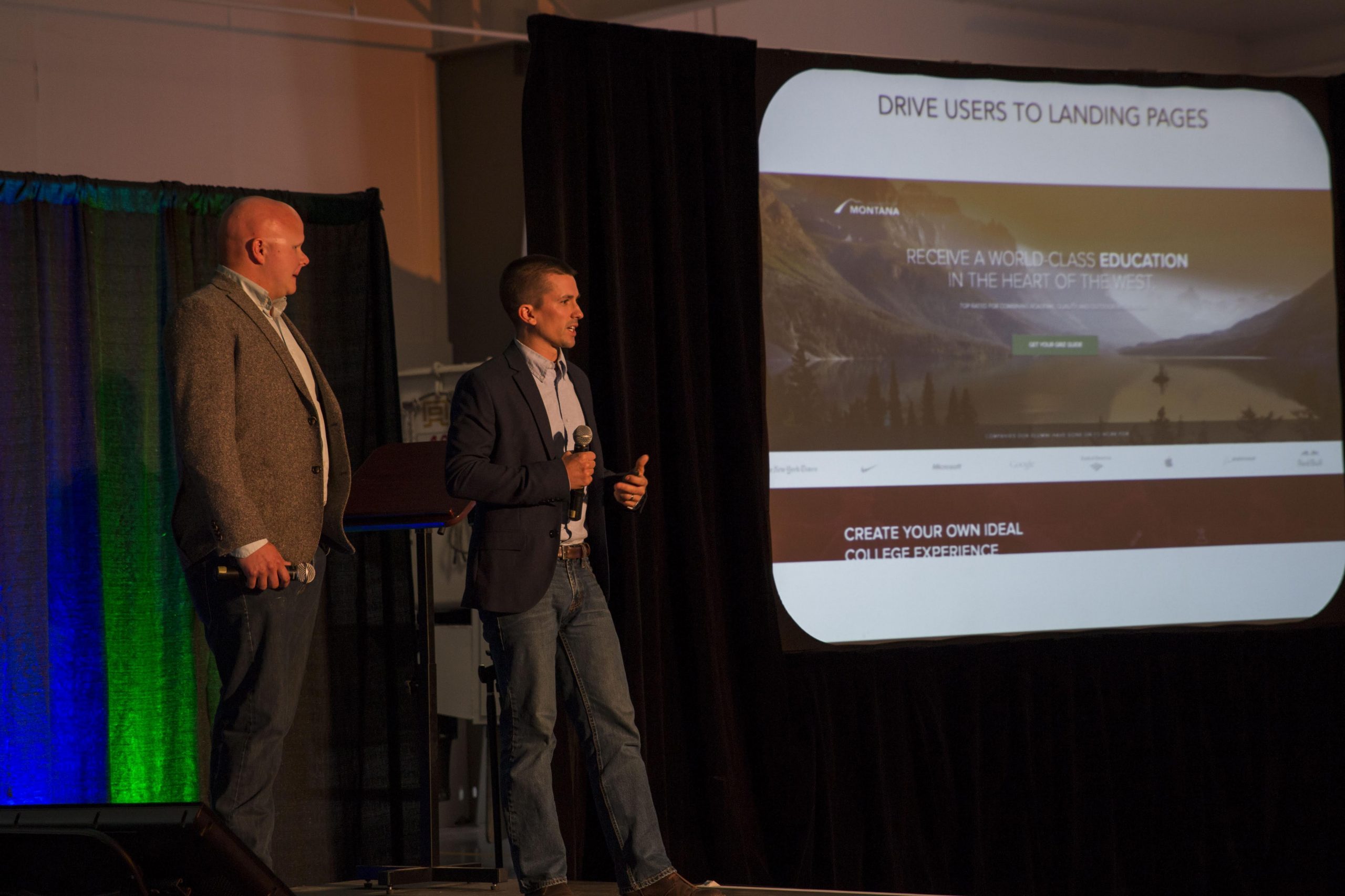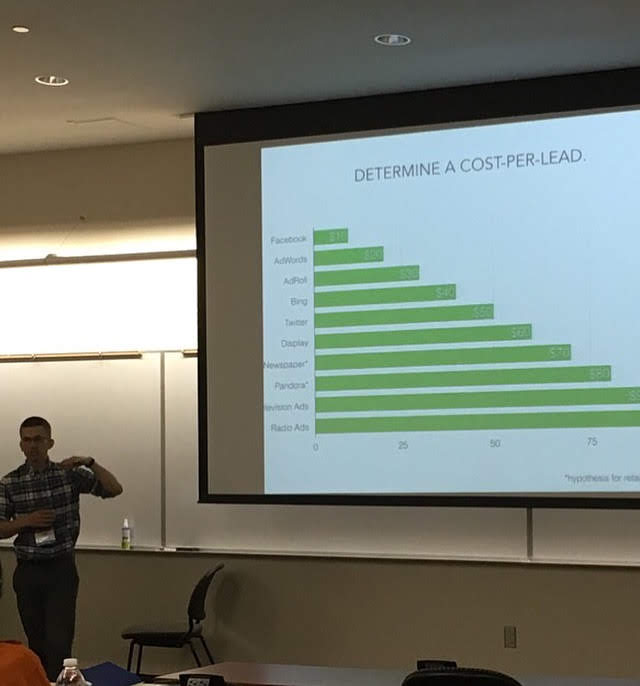Win a Speaking Proposal

The digital marketing world can be noisy. Submitting a speaking proposal to a conference is a great way to but through the noise. Clarity is often found in remote pockets of the internet delivered by trustworthy individuals. Rand Fishkin, Neil Patel and Seth Godin are a few of the folks online putting together consistently solid content in their respective areas of digital marketing expertise (SEO, Analytics and Marketing Strategy).
But where do you discover the up-and-coming talent in the digital marketing world? Conferences. Specifically, the breakout sessions at conferences. This week’s article focuses on finding and booking speaking engagements to grow your business. We used marketing as the example above, but it can apply to any crowded industry. Becoming a thought leader in your vertical can open doors you never knew existed.
Why Submit a Speaking Proposal?
When we think of speaking engagements, we think of a hub and spokes. When you attend a conference, you’re a spoke. Does that sound mean? It’s not. To put it another way, you’re a passive traveler through the conference agenda. When you’re a speaker at a conference, you immediately become the hub. The person people gather toward. The person people ask questions to and value their insight. Why? Because you made it through the vetting process to get yourself on that stage behind the mic. And that’s no easy task! The benefits of being the hub for the spokes are many.
Pros:
Unselfishly, you’re sharing wisdom in your field with people that are hungry for the knowledge. You’re potentially clearing a path or throwing the rope down from the top to make it easier for people to get to where you are. In the case of marketing, Pintler Group might share results from a campaign that was unsuccessful in order to help another marketing team avoid the same mistakes we made. What geotargeting softwares are we using? Are there form completion softwares that we find useful for lead generation? We’ll test and write digital marketing analysis for them.
Selfishly, your status in your field increases. With great presenting power comes great responsibility. You might gain LinkedIn followers that help your future articles get more eyeballs and new features or products get more shares. Your company is mentioned in the conference program next to your name: Sara Williams, Chief Financial Officer for Sherpa.shera, a dating app connecting Sherpas with other Sherpas, talks about the busy climbing season and how to plan for cash-flow windfalls. Your business gets exposure to a valuable audience of connectors.
Conference Attendees:
Are no slouches. These are, in the words of Malcolm Gladwell, mavens, connectors and influencers. All congregating in the same spot. It’s a big opportunity to get in front of them and make your case. Your speaking proposal should be directed at them. What are they topics they care about?
The Research Phase:
List building. Behind every conference speaker is a Google Sheet filled with links to pitch your proposal. Perhaps the least glamorous part of finding speaking engagements starts with the first step. List building. And just like adult-league flag-football, it’s important to recognize what division you belong in.
Set The Bar Low:
While not the advice you’d get from your fourth-grade teacher, the real world (conference planning committees) can be cruel and unforgiving. If you’ve never spoken at a conference before, it’s okay to start at the local entrepreneurial meetup held at the Best Western conference room. Find those local meetups and see if they’re in need of a speaker at their next event. The goal of setting the bar low early and often is to give yourself a couple W’s. Confidence and some momentum allows you to up the bar and take your speaking show on the road.
Finding a Conference to Speak At:

In the book, Where Good Ideas Come From, Steven Johnston talks about “the adjacent possible.” We love this concept at Pintler Group and apply it to a lot we do. The concept involves metaphorical doors that open illuminating the adjacent room.
Darwin’s theory of evolution was the result of traveling to different continents and compounding knowledge of different species found on islands, coast-lines and jungles. YouTube was made possible by the brilliant work of engineers at Adobe that solved sharing and uploading video on the internet easy. Youtube build a billion dollar business that ultimately sold to Google on the backs of that tech.
Apply the concept to conferences you could potentially speak at and you unlock some pretty amazing opportunities. Specifically, think about the industries that are “adjacent” to your own. We find that digital marketing conferences are, as predicted, filled with other digital marketers. And as a result, it’s tough to come to the table with something brand new, bold or that stands out. We use platforms like podcasts, articles and video to promote our messages, and when we attend a conference, we meet a lot of people doing similar things.
An adjacent conference (in the metaphorical room next to digital marketing) could be a conference all about video production filled with videographers that are technicians and masters in their craft, but then don’t have a way to promote the amazing videos they produce for their clients.
An adjacent conference could be a conference all about an emerging industry: solar power. Trying to pitch a presentation at a solar power conference stands out: how to use social media to educate early adopters and early majority about the benefits of solar. Or: Shout through a megaphone. Ways to promote big wins with solar.
Once you’ve found a couple adjacent industries you think would be up your alley, start submitting! Submissions can take a while to curate and you want to make sure to personalize and customize for the vertical you’re pitching. Using the examples above, the presentation to videographers would be different than the solar conference. Even if you’re running through a framework that you love, apply it correctly to the industry you’re pitching.
Speaking Topics = Subject Lines
If you’re in marketing or if you’ve ever sent an email newsletter, you know the importance of subject lines as it relates to the all-important open rate. The same is true on the judging and receiving end of a speaking proposal. Conference board members and committees want the choice to be difficult when attendees are deciding which breakout to attend: they all sound so good!
Your job is to imagine yourself and your speaking topic in bold letters at the top of a conference packet and work backwards.
What Are You Best In the World At?
Position your speaking proposal around a topic or skill that you’re best in the world at. It’s okay to go narrow and deep here. When we attend conferences, we want to hear from experts and gain some insights and something practical to take back to our team.
Do Something I Can’t Find on YouTube
Have you ever sat through a presentation and thought: I could have just stayed home and learned that on YouTube? YouTube has made learning from experts incredibly easy. The question becomes, how can you provide value to the individuals that ponied up the money to fly middle-seat across the country, leave their families behind, navigate a new city to find the conference, navigate their morning coffee with a time-zone change to attend (among other things) your presentation. Are there ways to involve the audience outside of your favorite slide-deck?
Video Yourself Speaking:
Many speaking proposals require the applicants to submit a link to a video of themselves speaking. Don’t have one? Make one! It’s pretty simple these days with a powerful camera in your pocket to take really sharp video. It might be worth investing in a quick microphone. But that’s about it. If you do land that speaking gig, make sure to have someone in the audience record the presentation for submission in future pitches. That way you’ll be able to show that you were actually in front of an audience 🙂 Future speaking proposals will benefit and the cool part about the recording is that it’s evergreen content.
Huddle and share:
One way great educators from first grade up to graduate school engage participants is to quickly discuss a question in a group of three or four, and then the presenter picks a few to share out loud. An experience that is tough to do from your couch while watching YouTube.
Ask participants to write things down.
A study by psychologist Gail Matthews showed that when people wrote down their goals, they were 33% more successful in achieving them than those who formulated the goals in their heads. Use this knowledge to engage your speakers. Have them write down the key takeaways and what they want to achieve in the next 90 days or implement in the next 90 days. Hopefully you’ll see everyone in the audience writing furiously. Adding this to your presentation separates it from YouTube and adds a bit more value to the participants.
Network and questions:
Of course, the real value of conferences and speaking engagements comes from meeting and other influencers and connectors in your vertical. Check out this video we made all about leveraging your speaking engagements for your Business. And as always, let us know if you have any questions.
Don’t forget to check out our podcast all about marketing and helping your business cut through the noise.

